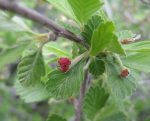 Also known as alder-leaf mountain-mahogany, alder-leaf cercocarpus, and true mountain-mahogany, this mostly deciduous long lived shrub or small tree grows in chaparral scrub, and on mesas and the lower foothills from Montana, Idaho, and South Dakota south to northern Mexico. It is a member of the rose family, Rosaceae, that also includes cherry, almond, and lady’s mantle. The plants have open branching with mahogany red to brown stems that can be fissured or scaley, and can grow up to 20′ tall, but are usually 5-12′ tall due to wild life browsing. The leathery, lanceolate to obovate leaves range in length from 0.4 to 2″ and are prominently veined and may be coarsely toothed. They are green on the top, hairy white on the underside until fall when they turn russet. In early summer, insignificant flowers appear singly or in cluster of up to 12. The flowers lack petals but have yellowish white sepals forming a tube with 5 lobes and give way in the fall to fruit with a silky, silvery white plume that is 2-5″ long. A shrub covered with fruits and their plumes is especially attractive when backlit. Plants are very drought tolerant and if pruned hard to promote dense growth can be used as a hedge or screen. The genus name, Cercocarpus, comes from the Greek word kerkos meaning a tail and karpos meaning a fruit and refers to conspicuous plumed fruit. The specific epithet, montanus, comes from the Latin word mons, meaning mountain, and refers to the native habitat of the plant.
Also known as alder-leaf mountain-mahogany, alder-leaf cercocarpus, and true mountain-mahogany, this mostly deciduous long lived shrub or small tree grows in chaparral scrub, and on mesas and the lower foothills from Montana, Idaho, and South Dakota south to northern Mexico. It is a member of the rose family, Rosaceae, that also includes cherry, almond, and lady’s mantle. The plants have open branching with mahogany red to brown stems that can be fissured or scaley, and can grow up to 20′ tall, but are usually 5-12′ tall due to wild life browsing. The leathery, lanceolate to obovate leaves range in length from 0.4 to 2″ and are prominently veined and may be coarsely toothed. They are green on the top, hairy white on the underside until fall when they turn russet. In early summer, insignificant flowers appear singly or in cluster of up to 12. The flowers lack petals but have yellowish white sepals forming a tube with 5 lobes and give way in the fall to fruit with a silky, silvery white plume that is 2-5″ long. A shrub covered with fruits and their plumes is especially attractive when backlit. Plants are very drought tolerant and if pruned hard to promote dense growth can be used as a hedge or screen. The genus name, Cercocarpus, comes from the Greek word kerkos meaning a tail and karpos meaning a fruit and refers to conspicuous plumed fruit. The specific epithet, montanus, comes from the Latin word mons, meaning mountain, and refers to the native habitat of the plant.
Type: Deciduous shrub or small tree
Outstanding Feature: Drought tolerance
Form: Vase-shape
Growth Rate: Slow
Bloom: Insignificant flowers lacking petals but with yellowish white sepals in early summer
Size: 5-20′
Light: Full sun
Soil: Average, dry to medium moist, well-drained
Hardiness: Zones 5-10
Care: Can be pruned hard, and to the ground, if desired or necessary.
Pests and Diseases: None of significance
Propagation: Seed, cutting
Photo Credit: Nadiatalent-Wikipedia